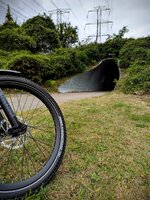So you have owned three Riese and Muller bikes. I have to ask myself why, given your apparent angst about them.
As to weight, well, my touring/bikepacking tends to be more remote, such that I have carried 35 litres of water/20 days of food on/behind my Surly Long Haul Trucker on one section and on my Surly Mutluk riding sandy 4WD track, beaches and pushing the bike up banks off beaches (one memorable occasion was up a flowing creek) with ~ 10 litres of water on board. I also had to push that bike up down steps on a walking path to access the next beach (not fun).
So, my point is it is just what it is for me.
So far, I have not found the Supercharger 'heavy', and whilst it means a change in my touring style, in a week or so, I will be riding ~150 km of which ~80% will be off bitumen between wall plugs (two days) and carrying six+ litres of water.
This was, IIRC, day three, where I was loaded up with all that water and food.
View attachment 177879
Ten litres of water on the bike (yes badly secured. I changed bladder style after this trip) with the start of the steps in the background.
 Welcome to the Hakea Trail - {Day 06-07}
Welcome to the Hakea Trail - {Day 06-07} by
Andrew Priest, on Flickr


